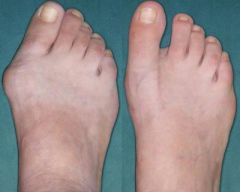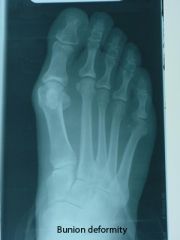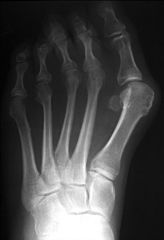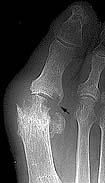![]()
![]()
![]()
Use LEFT and RIGHT arrow keys to navigate between flashcards;
Use UP and DOWN arrow keys to flip the card;
H to show hint;
A reads text to speech;
30 Cards in this Set
- Front
- Back
|
What are the stepwise approach of the lateral release?
|
Release DTML
Release adductor tendon Release fibular sesamoid |
|

What are some common causes of HAV?
|
Pronation
90% genetic correlation Arthritis Trauma Neuromuscular disease Shoe pressure |
|
|
Name some examples of neuromuscular diseases that cause bunions.
|
Poliomyelitis
Cerebral vascular accidents Charcot arthropathy Myotonic dystrophy Cerebral palsy Gullain Barre Multiple sclerosis |
|
|
What are some arthritic causes of HAV?
(any disease that causes an INFLAMMATORY rxn of the mPJ that will eventually alter the extensor and flexor tendons of the hallux) |
RA
Psoriatic arthritis Osteoarthritis |
|
|
What are some traumatic causes of HAV?
|
Hallux rigidus
limitus removal of tibial sesamoid crushing injury sprain injury |
|
|
What are some genetic disorders that can result in HAV?
|
Marfans
Ehler danlos Downs syndrome Williams syndrome Saethre chatzen syndrome Multiple synostosis syndrome Fibrodysplasia ossificans progressiva |
|
|
Medially, the structures will be elongated.
Laterally, the structures will be very tight. In normal first ray biomechanics, the first ray will plantar flex, but if the calcaneus is everting (as in pronation) -- the first ray will dorsiflex causing impaction. What muscle is responsible of first ray plantar flexion during propulsion? |
Peroneus Longus
|
|
|
What are the requirements for 1st ray PF?
(there are 4) HINT: H - S - S- S |
HEEL LIFT
S TJ supination S horter 1st MT than 2nd MT N ormal sesamoid function |
|
|
T/F
Metatarsus adductus, metatarsus primus varus, & collapsing pes plano valgus are all examples of abnormal biomechanical foot function that could lead to HAV. |
TRUE.
|
|
|
Hallux valgus is a triplane deformity.
It occurs in 3 planes. Hallux is rotated with dorsal or plantar deviation. What plane does this occur in |
Sagittal
|
|
|
Hallux is laterally rotated towards lesser toes. What plane does this occur in?
|
Transverse
|
|
|
Valgus rotation of the hallux so that plantar aspect is more prominent laterally. Occurs in what plane?
|
Frontal
|
|
|
The biomechanics of the 1st MPJ exhibits 2 distinct axes of motions:
Vertical & Transverse --------- Transverse allows what motions? |
Transverse:Pure DF & PF of the hallux
Vertical: Adduction & Abduction remember: an axes is a line around which a plane of motion occurs. in other words, the MPJ functions like a door hinge. the door hing is located upon a vertical axes, therefore allows open & closed swinging of the door. ie: good method to explain biomech. GOLDEN RULE; motion in joint must occur PERPENDICULAR to the axis. |
|
|
No axis of motion occurs in the frontal plane b/c if there was motion in the frontal plane of the MPJ, it would result in ______________---
|
Any eversion/inversion can likely result in subluxation or jamming of the 1st MPJ
|
|
|
Phases during ambulation include:
DISTRACTION GLIDING COMPRESSION Distraction is: |
the 1st phase of DF that increases joint space for the next phase
|
|
|
Gliding is:
|
As the MT PF, and the hallux moves to increase DF and extension of the MPJ
|
|
|
Compression ocurrs:
|
At the end of ROM, proximal phalanx compresses against the dorsal surface of the metatarsal head allowing the rigid level to become complete.
|
|
|
What is hypermobility's relationship to HAV?
|
The amt determines the rate of development of HAV.
|
|
|
In what planes does HAV characterized by?
|
Sagittal plane, Transverse plane
|
|

Describe what happens in STAGE 1 of HAV formation.
|

Lateral subluxation of the base of the proximal phalanx of the hallux in relation to the 1st met head.
It can be seen in the AP view. Efficiency of PL muscle to PF the 1st ray is reduced. |
|

In a stage 2 deformity, what occurs?
|

Hallux is seen to place pressure against 2nd toe.
Hyperkeratotic lesions of the contiguous surfaces of the hallux and 2nd toe indicate large pressure force as hallux abducts. |
|

What does stage 4 HAV look like?
|
Dislocation or major subluxation of the hallux.
Hallux frequently underrides the 2nd toe and becomes abducted. Arthritic changes. |
|
|
What are the 3 intrinsic muscles that surround the 1st MPJ?
|
EHB
ABD H ADD H |
|
|
Concerning the sesamoids---
the Medial sesamoid in embedded in the medial head of the tendonS ______ & ___________ |
ABD HALL.
FHB |
|
|
The lateral sesamoid is embedded in the lateral head of the tendons ___________& ___________
|
ADD HALL
FHB |
|
|
What is trackbounding?
- |
The hallux is passively taken through DF through sagittal plane excursion.
If hallux can't be brought back to rectus position, it is considered track bound. In other words, the lateral deviation of the hallux stays the way it appears in HAV, despite manually moving it. |
|
|
What is tracking?
|
If the hallux can be moved back into a rectus position but has a tendency to deviate back laterally, this is known as TRACKING.
This occurs PRIOR to the joint being trackbound, and indicates soft tissue contractures on the hallux. |
|
|
Reverdin & Peabody both correct what angle?
|
PASA
|
|
|
Reverdin is performed in the ________ of the metatarsal.
|
Head of the met
|
|
|
Peabody is performed in the ___________ of the metarsal.
|
Neck of the met
|

